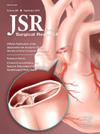Factors Influencing End-of-Life Decisions in Cancer Patients After Traumatic Injuries
IF 1.7
3区 医学
Q2 SURGERY
引用次数: 0
Abstract
Introduction
Severe traumatic injuries are frequently associated with poor outcomes, and withdrawal of life-sustaining treatment (WLST) after traumatic brain injury is common. However, the association between WLST and pre-existing cancer in all trauma patients remains underexplored.
Methods
This retrospective cohort study analyzed data from the American College of Surgery Trauma Quality Programs in 2022. Patients aged 18 y or older with information on pre-existing disseminated cancer and chemotherapy status at the time of trauma were included. Descriptive statistics and multiple logistic regression, combined with propensity score matching, were used to assess the association between WLST and pre-existing cancer after traumatic injury.
Results
A total of 936,410 patients met the study criteria. Of these, 3827 (0.4%) were undergoing chemotherapy without metastatic cancer, 1528 (0.2%) had metastatic cancer but were not receiving chemotherapy, while 5399 (0.6%) were on chemotherapy. Significant differences in patient demographics, injury characteristics, and outcomes were observed across these groups. After matching on age, sex, race and ethnicity, insurance, injury severity, region and type, advance directives (ADs), functional dependence, prehospital cardiac arrest, and initial Glasgow Coma Scale, the adjusted odds ratio for WLST was 2.02 (95% CI: 1.39-2.95) for patients with metastatic cancer not on chemotherapy and 2.47 (95% confidence interval [CI]: 1.78-3.42) for patients with metastatic cancer on chemotherapy, compared to patients without cancer. Severe injuries were associated with 2.83 times higher odds of WLST (95% CI: 2.42-3.71) compared to mild injuries. Patients with chest, abdominal, and extremity injuries had lower odds of WLST compared to head and neck injuries. The presence of ADs limiting care was strongly associated with WLST (adjusted odds ratio: 3.62, 95% CI: 2.91-4.51).
Conclusions
Patients with metastatic cancer, regardless of chemotherapy status, had up to three times higher odds of WLST after traumatic injury. The presence of ADs was also strongly linked to increased WLST, emphasizing the importance of patient preferences and personalized care approaches in end-of-life decisions for cancer patients in trauma settings.
影响创伤后癌症患者临终决定的因素
严重的创伤性脑损伤通常与不良预后相关,创伤性脑损伤后停止生命维持治疗(WLST)是很常见的。然而,在所有创伤患者中,WLST与既往癌症之间的关系仍未得到充分探讨。方法本回顾性队列研究分析了2022年美国外科创伤质量项目学院的数据。患者年龄在18岁或以上,创伤时已有播散性癌症和化疗情况。使用描述性统计和多元逻辑回归,结合倾向评分匹配,评估创伤后WLST与先前存在的癌症之间的关系。结果936,410例患者符合研究标准。其中,3827人(0.4%)正在接受化疗,但没有转移性癌症,1528人(0.2%)有转移性癌症,但没有接受化疗,5399人(0.6%)正在接受化疗。在这些组中观察到患者人口统计学、损伤特征和结果的显著差异。在匹配年龄、性别、种族和民族、保险、损伤严重程度、地区和类型、预先指示(ADs)、功能依赖、院前心脏骤停和初始格拉斯哥昏迷量表后,未接受化疗的转移性癌症患者的WLST校正比值比为2.02 (95% CI: 1.39-2.95),接受化疗的转移性癌症患者的WLST校正比值比为2.47(95%可信区间[CI]: 1.78-3.42)。与轻度损伤相比,重度损伤发生WLST的几率高2.83倍(95% CI: 2.42-3.71)。与头颈部损伤相比,胸部、腹部和四肢损伤的患者发生WLST的几率较低。ad限制护理的存在与WLST密切相关(调整优势比:3.62,95% CI: 2.91-4.51)。结论转移性癌症患者,无论化疗状态如何,创伤性损伤后WLST的发生率高达3倍。ad的存在也与WLST的增加密切相关,强调了患者偏好和个性化护理方法在创伤环境中癌症患者临终决定中的重要性。
本文章由计算机程序翻译,如有差异,请以英文原文为准。
求助全文
约1分钟内获得全文
求助全文
来源期刊
CiteScore
3.90
自引率
4.50%
发文量
627
审稿时长
138 days
期刊介绍:
The Journal of Surgical Research: Clinical and Laboratory Investigation publishes original articles concerned with clinical and laboratory investigations relevant to surgical practice and teaching. The journal emphasizes reports of clinical investigations or fundamental research bearing directly on surgical management that will be of general interest to a broad range of surgeons and surgical researchers. The articles presented need not have been the products of surgeons or of surgical laboratories.
The Journal of Surgical Research also features review articles and special articles relating to educational, research, or social issues of interest to the academic surgical community.

 求助内容:
求助内容: 应助结果提醒方式:
应助结果提醒方式:


